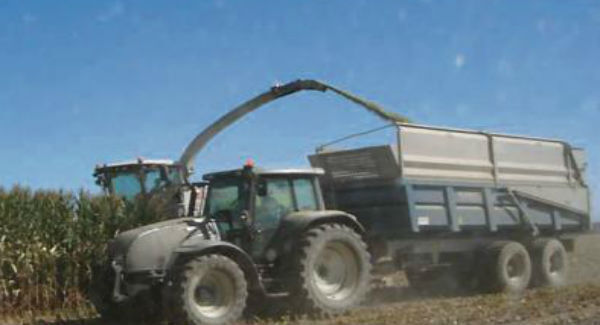Irish farmers producing more maize than French counterparts

It’s a French crop that grows better in Ireland.
Much of the seeds for the maize silage sown here come from France. So it’s somewhat ironic that Irish farmers can now expect to produce 50% more maize silage per hectare than many of their French counterparts.
This year, drought damage has cut an estimated 28% off French grain and silage maize output, plunging production to a nine-year low.
In contrast, it was a good year for maize silage in Ireland.
Yields here have averaged 17 tonnes of dry matter per hectare in recent years, whereas French farmers were averaging only 11-13 tonnes with their silage crops.
Drier summers, which may be linked to global warming, have reduced maize silage yields in much of France.
Among some of the French milk producers worst affected by the global milk price slump of recent years, there’s talk of moving away from maize after 50 years of depending on the crop, and switching back towards pastures, maybe in conjunction with organic milk production.
Although dry conditions have reduced French maize silage yields, it’s still a leader in maize genetics and in maize- seed production.
French National Federation of Seed Maize and Seed Sorghum Production figures show 244,000 hectares of maize seed is grown in Europe.
France has the biggest share, with 76,000 hectares.
French-produced varieties are the result of decades of genetic progress in French plant breeding, which has increased yields more than 1% per year on average since the 1950s, with particular improvement in the cold tolerant early varieties that do well in Ireland.
Early maturity, resistance to lodging, and yield consistency have been the main targets of plant breeders, along with high energy and digestibility in silage.
While many French milk producers in the drier areas are averaging only 11-13 tonnes of dry matter per hectare, thousands of their colleagues will continue to make a good income from producing the seed maize needed for Europe’s annual crop of about 27.2m hectares.
Germany, with its huge biogas industry, is the No 1 market for French maize seed, which is 60% for export.
Ireland is one of their smaller export destinations, but when Kevin Cunningham, business manager at DLF, and chair of the Maize Industry Group of Ireland, recently addressed the European Corn Committee annual meeting in France, he said the maize varieties coming onto the Irish recommended list in the last few years have improved greatly due to better selection, and due to more focused selection by DLF and other seed companies.
He told the European Corn Committee the market in Ireland is 85% under film now, which has reduced the yields and quality variability of the crop. Our current maize crop is about 11,500 hectares, down from nearly 25,000 in 2008, but predicted to recover to 16,000 hectares.
For Ireland, maize silage is a high-energy, high-starch feed that complements grazed grass, with a production cost of about 12c per kg of dry matter, which is similar to first-cut grass silage, but less than half the 30c cost of concentrates.
High-quality maize can boost milk solids.
Maize is cheaper per unit of energy than grass silage, so it’s a viable option in Ireland for replacing concentrates, said Mr Cunningham.
He predicted the Irish crop will increase 20% to 30% in the next five years, as cow numbers pick up on medium to high-stocked dairy farms.
Growing it under a plastic film has been a major advance, because the seed needs a 6C to 8C soil temperature to germinate, and needs all the sunshine and heat it can get, which it converts rapidly into dry matter, continuing to grow — even every night — if conditions are favourable in its relatively short growing season.

Growing the seeds for EU’s maize crop is a 30 hours per hectare labour
A maize crop can be worth €4,000 per hectare to the thousands of French farmers who grow it as a seed crop.
However, their costs are high, with painstaking crop care needed to ensure the high quality of the seed from their 76,000 hectares, more than half of which is exported around Europe.
However, growers enjoy a guaranteed market for contracted seed maize, even if it takes an estimated 30 hours of work per hectare to get it right.
It’s still the most profitable crop in most French tillage areas.
It’s a complicated crop, because the hybrid varieties of maize introduced from the US to Europe in the 1950s have taken over.
With hybrids, it’s not an option for a farmer to reuse maize kernels from his own crop, he has to buy new seed.
To breed hybrid maize, rows of female plants must be established in the field, separated from those that will grow to perform as male plants.
The pollen produced in each tassel (on male plants) fertilise the cobs (on female plants).
To stop plants self-pollinating, they must be detasseled, a manual seed crop job which takes two people to detassel one hectare per day. Repeated detasseling is carried out up to five times. However, automatic detasseling machines are being used more and more.
Another unusual task for seed growers is removing the rows of male plants after pollination is completed.
In total, the seed maize grower can expect to go into the crop about 20 times from sowing to harvest, when pesticide applications are included. The harvested maize ears go to the seed plant within 24 hours in aerated trucks, and are dried from 35%-40% moisture down to about 12%.
At the end of the production line, each of the 15kg bags of maize seed has about 50,000 high quality seed kernels, produced according to the specifications of intended markets across Europe.
Maize silage growers in Ireland will be glad to hear that the French maize breeding sector, well known for quality, isn’t resting on its laurels, but is instead investing €27.5m in its Amaizing project, aimed to support its competitiveness, sustainability and quality.
The project runs from 2012 to 2020 and will combine genetics, genomics, and analyses, to further improve seed traits of agronomic interest, such as yield, quality and tolerance to stress. Meanwhile, the Maize Industry Group of Ireland has been formed, prompted by the big fall in acreage since the 2008 peak.
It includes the Department of Agriculture, Teagasc, farmers, and seed agents and retailers.
One of the Maize Industry Group’s main aims is to publish an Irish maize guide (expected in 2017), with advice from sowing to feeding, to help Irish farmers fully exploit the potential of the crop.










